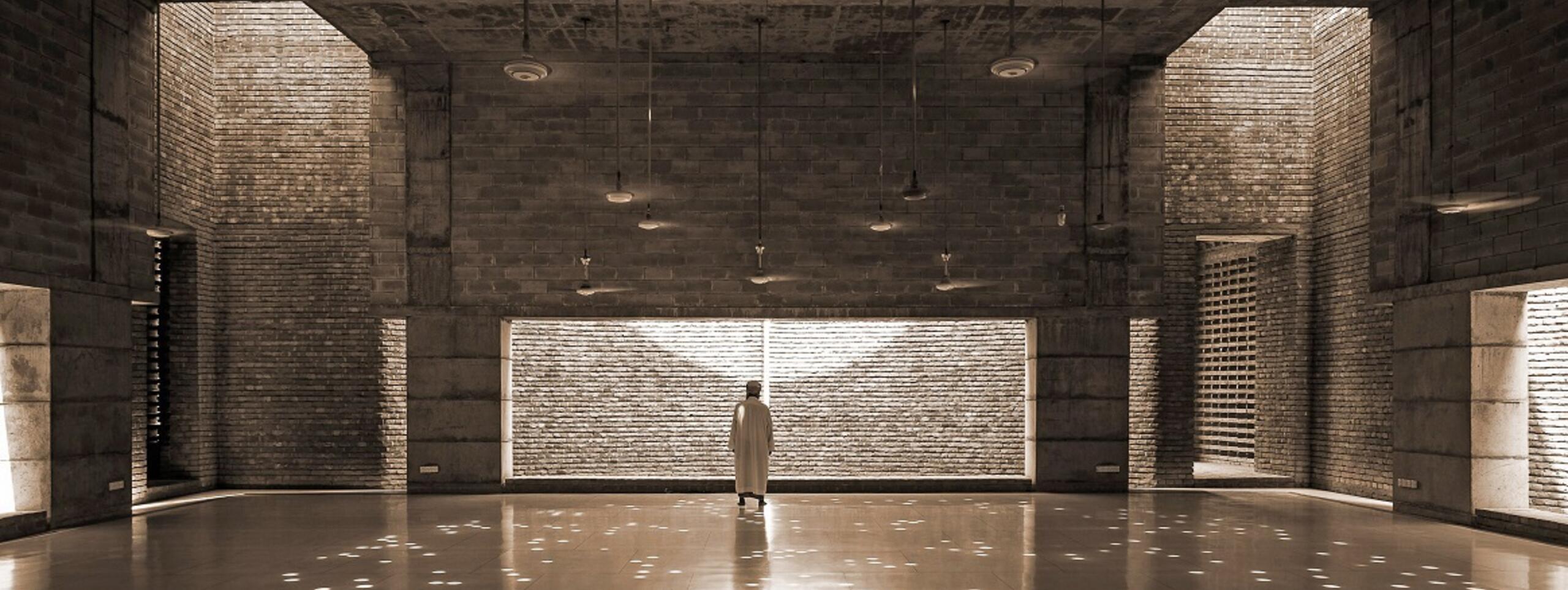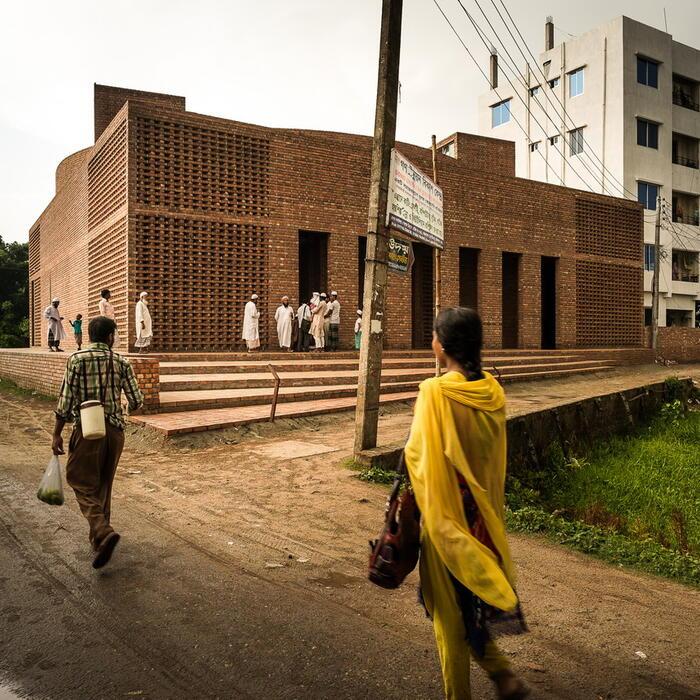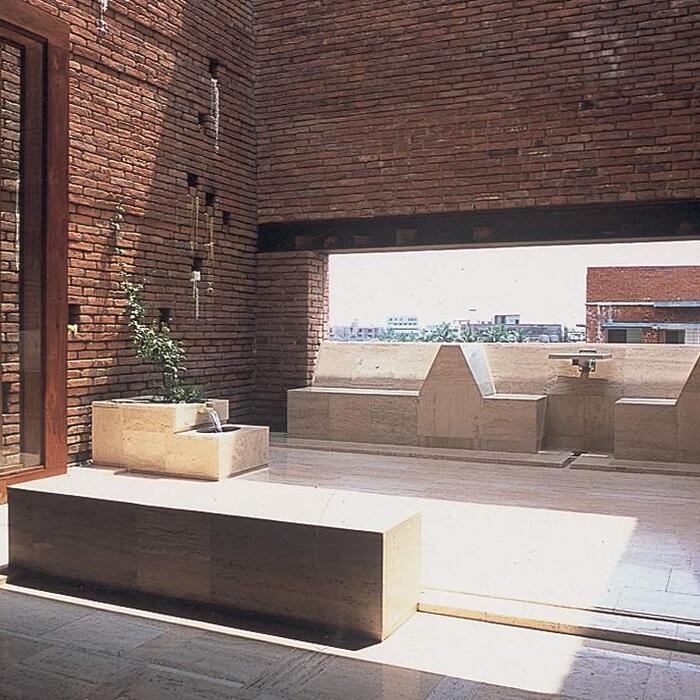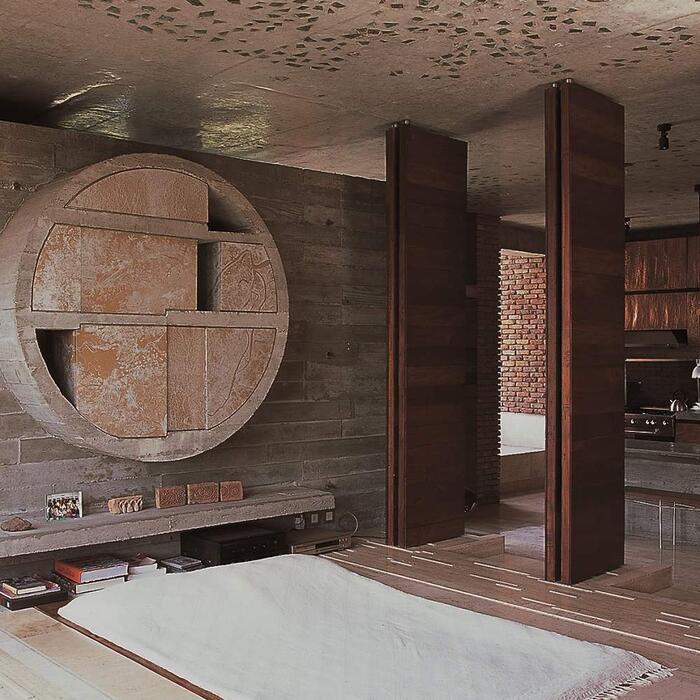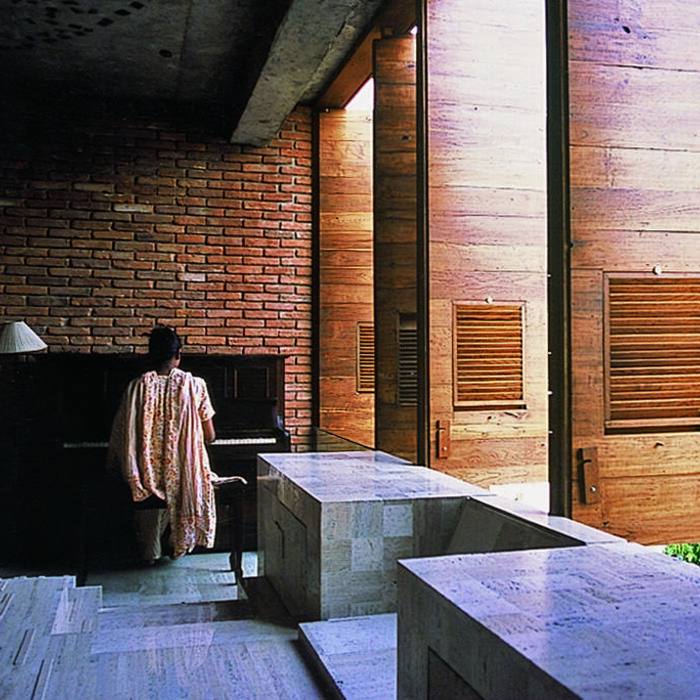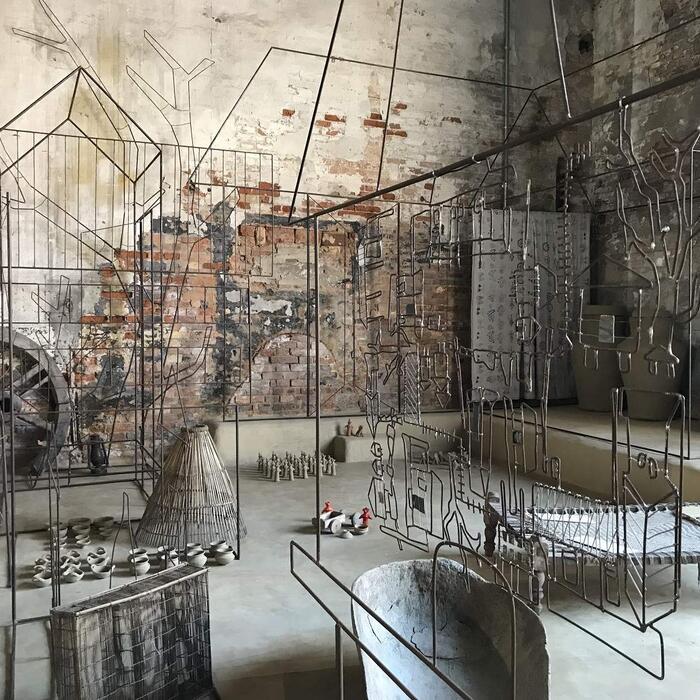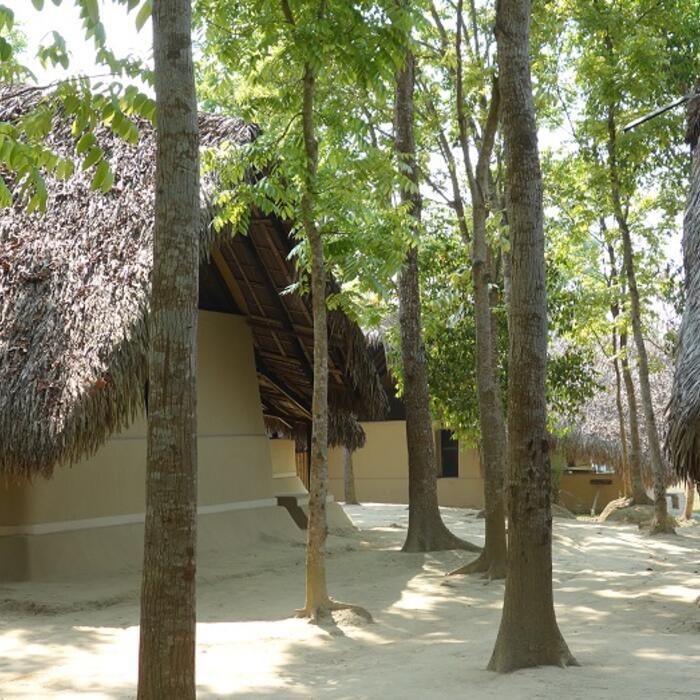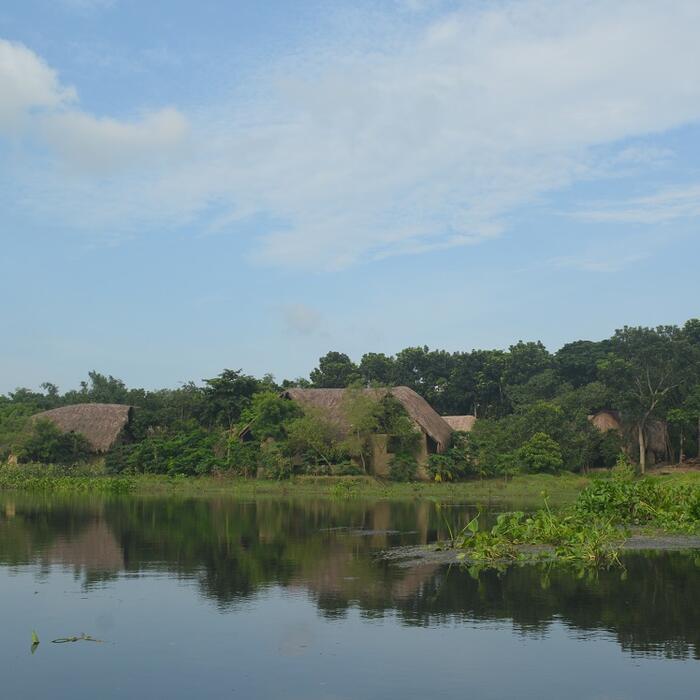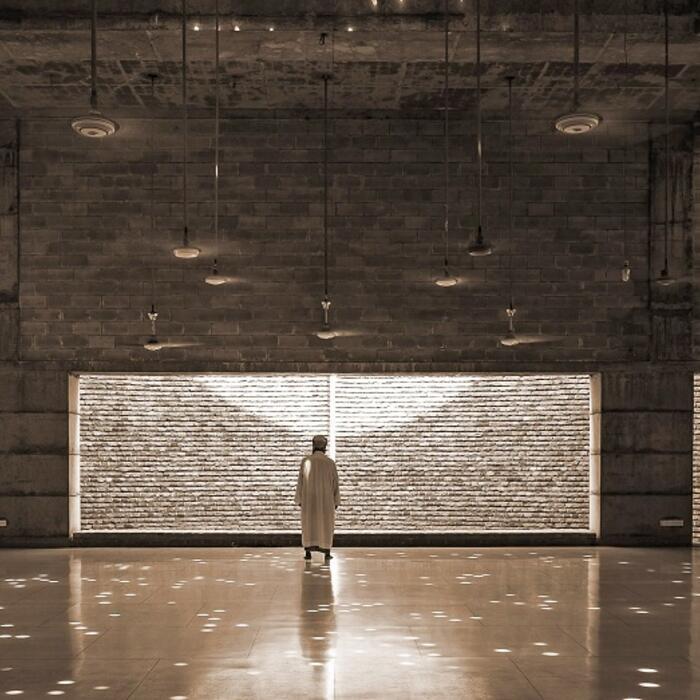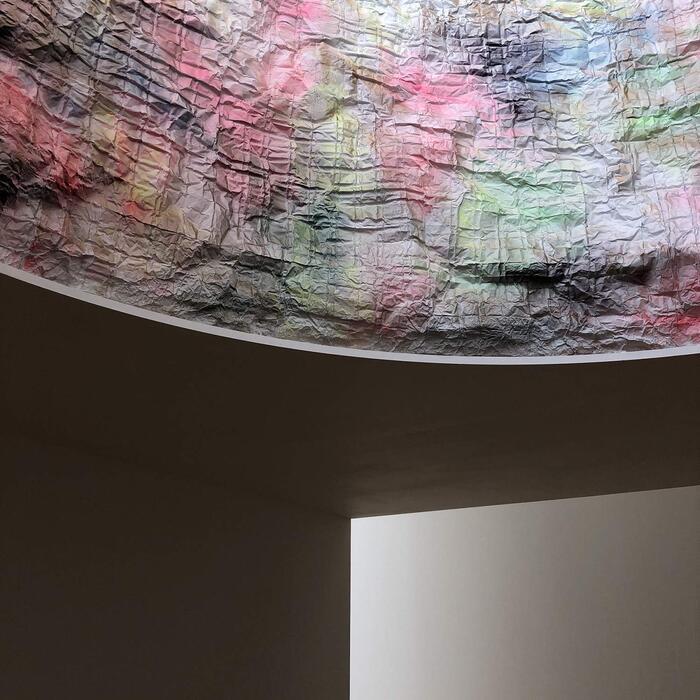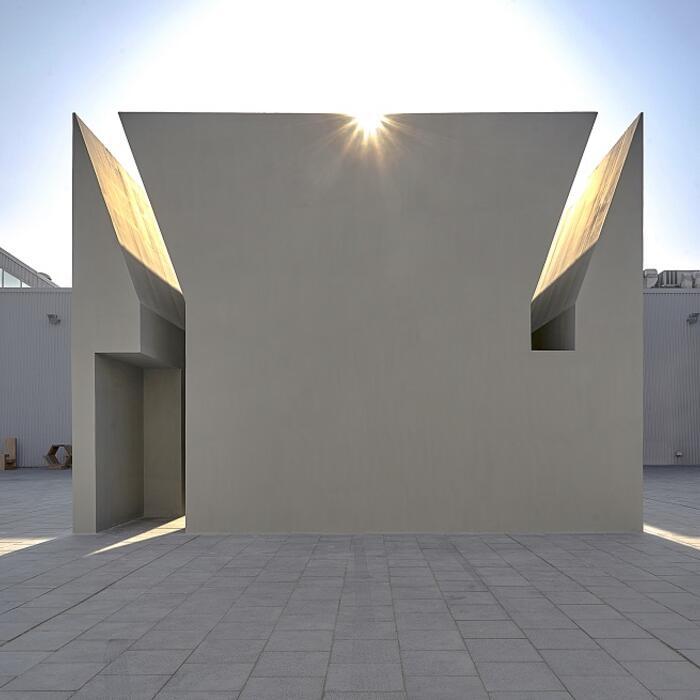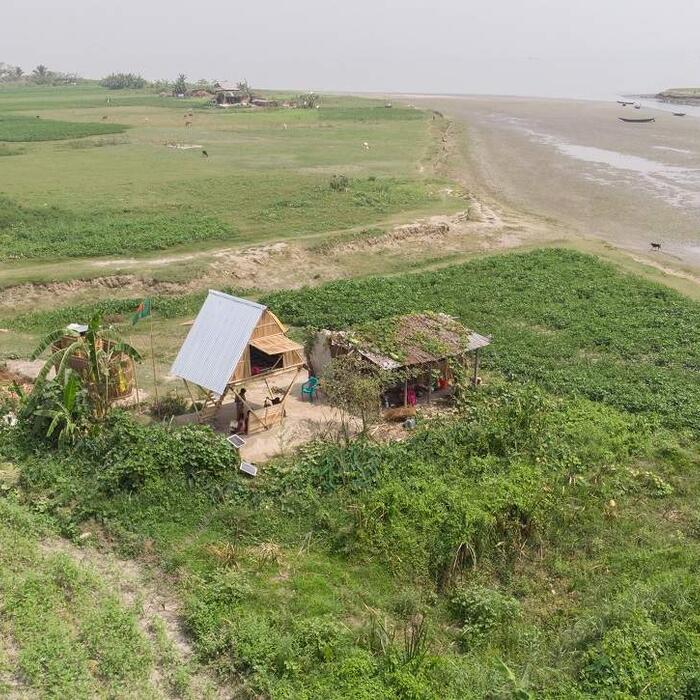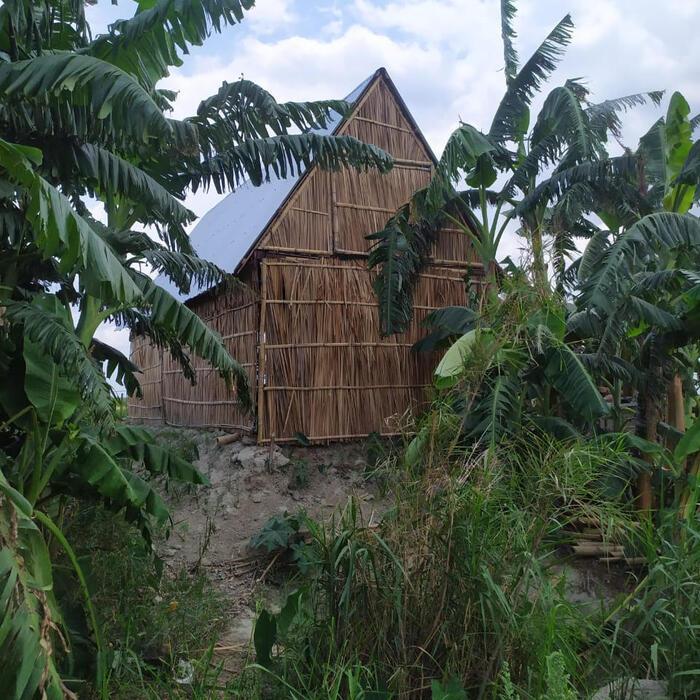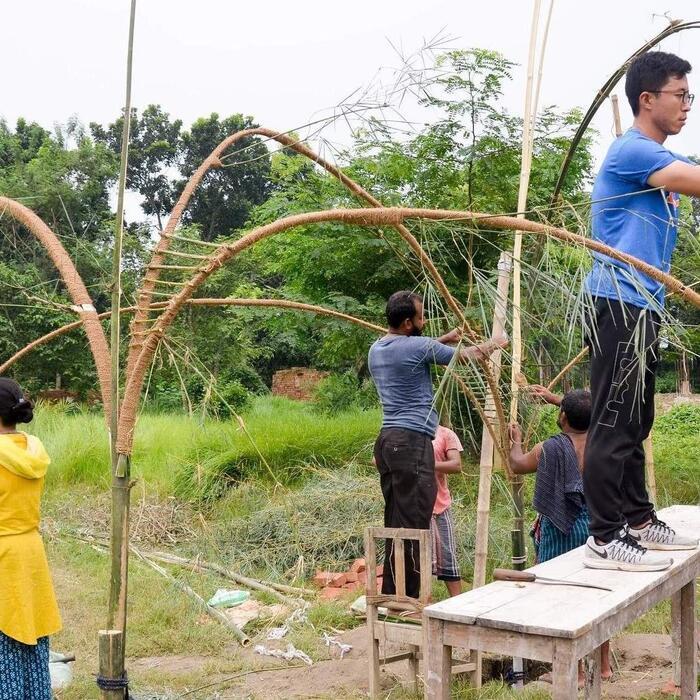Each year, the Soane Medal is awarded to a practitioner, historian, educator or writer who has made a lasting contribution to the field of architecture. In celebration of our 2021 medallist, five different expert voices reflect on the work and impact of Marina Tabassum.
Balkrishna Doshi Back to top
New expression
I am happy that Marina Tabassum is gradually rediscovering herself and giving expression to her inner urges and inner searches on what is architecture for Bangladesh. Her work is culturally rooted, and in one way it’s also a lesson for the younger generation.
I have met Marina a few times and have seen her work. I was impressed by her first building, the apartment in Dhaka. I must say, it is a remarkable work that deals with issues, such as what is the meaning of architecture, what is the meaning of space, what is the understanding of light. These are the concerns that Marina’s work expresses. The Bait Ur Rouf Mosque and the more recent work she is currently engaged with are examples of this deep-rooted search.
Bangladesh has wonderful bricks and a great tradition of making brick. Marina very sensitively picked it up, and in the process she has heightened the quality of the material that belongs to the local conditions.
So I would say that true regionalism comes from the graceful use of the materials that are locally available. In Marina’s work the brick has found a new expression and for that I would like to congratulate her for trying to give prominence to regionality alongside her concern for climate, technology and scale.
From those points of view her work is a great departure, a great innovation and an emphasis of what architecture should be. Needless to say, I am more than happy for her recognition and proud that she is excelling every time.
An architect, urban planner, and educator for the past 70 years, Balkrishna Doshi has been instrumental in shaping the discourse of architecture throughout India and internationally. He is the architect of numerous built works, including the Indian Institute of Management (Bangalore, 1977–92) and the Centre for Environmental Planning and Technology (Ahmedabad, 1966–12). In 2018 he was awarded the Pritzker Architecture Prize.
Brigitte Shim Back to top
Placemaking and modernity
I first became aware of the work of Marina Tabassum long before I ever met her. In 2007, while serving on the Aga Khan Award for Architecture jury, we reviewed a remarkable private residence located within a six-storey apartment building in Dhaka, Bangladesh. This exceptionally crafted project was clearly committed to modernity and placemaking simultaneously. The Pavilion Apartment blurred the boundaries between inside and outside. The exterior courtyard was the soul of the project, linking it to a long tradition of Mughal gardens. It provided a place of repose while ensuring natural ventilation within the vertical urban dwelling. Local handmade brick that had been skilfully installed showed us how earth can make magic. This sophisticated project stood in stark contrast to the numerous global projects that the master jury reviewed during the tenth award cycle. Even though this project did not receive an award, it left a deep impression on me. Many years later, I met Marina Tabassum, and I realised that she was one of the authors of this very knowing work. This early project is a laboratory and its many experiments and investigations provide a lens to view the body of work by Marina Tabassum Architects.
Marina Tabassum is amongst the early generation of architecture graduates from the Bangladesh University of Engineering and Technology. Her professors were mostly from Texas A & M and trained her colleagues to balance the poetics and the rational. Upon graduating, Marina quickly understood that Dhaka, like many global cities, was in the midst of an identity crisis as it erected so many placeless commodity buildings. She also observed the social inequity and disparity in many communities throughout her homeland. Many of her architecture classmates built successful design practices all around the world. Unlike her colleagues, Marina has never left home. She made a deliberate choice to live and work in Bangladesh. Her architectural practice is a force of resistance against the instant city, and she is always striving to realise built form that emerges directly from its place.
When Marina Tabassum lectures, she always begins with a lesson on the land. Her work emerges from the belief that geography, topography and climate give us our identity and uniqueness. She eloquently describes her birthplace as a dynamic delta where land and water are constantly in a state of flux. For Marina, impermanence created by the constant shift between land and water is linked to the psyche of the entire Bengal region. Monsoon season and growing seasons create distinct cycles that ebb and flow making it impossible to draw a singular line between land and water. The land is an eternal source of creative power that continually feeds and inspires Marina Tabassum’s poignant work as an educator and an architect.
Brigitte Shim is a principal of Shim-Sutcliffe Architects and a Professor at the Daniels Faculty of Architecture, Landscape & Design, University of Toronto.
Kazi Khaleed Ashraf Back to top
A Flow of Life
In her installation at the 2018 Venice Architecture Biennale, instead of showcasing her own work of a metropolitan verve or demonstrating a capability for abstract confabulation that most other architects posed, Marina Tabassum made a distilled presentation of a Bengali rural household in clay. The opening lines in the accompanying catalogue begin with a description of the first monsoon rain in an anonymous courtyard:
“First drops of monsoon rain, as they touch the earth vanish at the blink of an eye leaving a faint trace… The courtyard has been thirsty for a good rain. It hasn’t rained for five long months. The most blessed fragrance comes from the earth with the first shower of monsoon. An event of celebration in the Bengal Delta. As women rush to secure drying clothes hanging on the liner, children of the village run wild embracing the shower. It’s a happy rain.”
Such vivid attention to the delicate way of living in the Delta is a provocation for a new horizon.
The installation at the Biennale is a poetic homage to life in a village in Jessore, southern Bangladesh where Marina is developing a project called Panigram. Drawn from that project and its villages, the installation depicted the minimalist beauty of the clay courtyard (uthaan) of a house with various devices and agricultural tools that make for the theatre of life in the lush rural landscape. It’s perhaps a fine segue from the epic cinematic representation of the uthaan in Satyajit Ray’s classic film Panther Panchali.
Like the first drop of rain, leaving only a trace of its presence on earth, the house at the Biennale is a haunting extract from the Bengali landscape, reminding architects, if one were to listen, of the ethos of treading lightly. The everyday of a mundane house and its accoutrements was neatly turned extraordinary in the installation, revealing Tabassum’s studied exploration of village life as well as a deep connection with the people in the village. Tenuous as it is, the house is deeply connected to the landscape in its material, spatial and lived reality, which perhaps made it uncanny in the robust atmosphere at Venice. While the Baitur Rauf Mosque may be a condensation of her practices in an urban milieu – a beautifully crafted piece – and justifies a description of her as the elegant metropolitan architect, Marina Tabassum literally turns a new leaf with Panigram. It can be a great moralising and humbling lesson for architects, especially the urbane types, that architecture is not a one-off thing but embedded in the flow of life.
Kazi Khaleed Ashraf is a Bangladeshi architect, urbanist and architectural historian. He directs the Bengal Institute for Architecture, Landscapes and Settlements in Dhaka, Bangladesh.
Rana Begum Back to top
Truthfulness in Materials
In 2018, I was lucky enough to visit the Baitur Rauf Mosque during a visit to the Dhaka Art Summit. Marina’s use of light and material took my breath away. I felt an immediate connection to the space. I spent hours just observing, meditating, taking in the sense of calm.
Above all, Marina’s work really resonated with me and my own practice as an artist. I loved her emphasis on material, allowing it to speak for itself and not to be disguised or embellished. There is a truthfulness in this that speaks to me. Materiality is at the core of my work. I love the variability in texture, functionality and the way light is absorbed, refracted or reflected.
After this visit, Marina and I were both invited by the Whitechapel Gallery to participate in the Is This Tomorrow? exhibition of 2019. The gallery invited ten groups of artists and architects to collaborate and explore their visions of the future. Marina and I met up, talked, discussed, played around with materials in the studio. At the time, the political and social landscapes were turbulent. There was a lot of disconnect, an increase in barriers and isolation. However, Marina and I had a shared vision for the future: one of spaces that brought people together and allowed room for dialogue. For the exhibition, we felt there was a real need to create a meditative space – allowing the changing natural light to flood in was integral to this. When the space was realised, the next challenge was emphasising the light even more, to fully engage the viewer’s senses. We did this through the surface application.
After the Whitechapel exhibition, the work toured to Concrete, Dubai. At Concrete it was shown outside, which Marina and I agreed brought an additional layer to the work. The location allowed viewers to develop a different relationship with the work, one closely connected to natural elements.
Marina is an architect making buildings for people to live and work in. My work deals with space, colour and light. It requires material/medium to be manipulated to create experiences. I often think about my work as being architectural in nature, but ultimately most of the things that I make do not have a real function. The thing that we share is the wish to make spaces that are sensorially stimulating, and it is in this area that our collaborations have been most rich.
Rana Begum blurs the boundaries between sculpture, painting and architecture. Her visual language draws from the urban landscape as well as geometric patterns from traditional Islamic art and architecture. She is the recipient of the Jack Goldhill Award for Sculpture (2012) and the Abraaj Group Art Prize (2017). Born in Bangladesh, she lives and works in London.
Peter Buchanan Back to top
Notes on the architecture of Marina Tabassum
To appreciate Marina Tabassum’s architecture you must have some feeling for the sodden and unstable land that is Bangladesh. So, typically Marina opens lectures on her work with aerial photographs of Bangladesh. My memory is of a few exceptionally beautiful ones taken from high-up, which show a slowly shifting tapestry braided from water channels and emerald land that constantly move and interchange positions.
Then, coming into land at Dhaka, you see the river’s edges are lined with brick kilns and their tall smoke stacks, transforming soft grey mud into the pale red, fired brick necessary for stable construction. Although she used raw concrete for the Liberation War Museum and French German Embassy, her apartment blocks and towers are in this fairfaced and un-plastered brick – and exploit a stabilising and static four-square geometry as found in Islamic architecture. She continues to design in this fusion of abstract modernity and Islamic geometric discipline to invest her buildings with a calmly resonant dignity as found in the Baitur Rauf Mosque.
But Marina Tabassum is now also working with rural communities, adopting very pragmatic and contrasting formal and technical approaches to meet climatic and socio-economic challenges. The Khudi Bari project, for example, consists of a cheap, quickly assembled, modular and easily moved emergency relief dwellings for flood victims. Its triangulated bamboo frame can be clad in locally available materials, while its sheltered raised upper floor remains above flood levels.
For the 2019 Sharjah Triennial, she exhibited an equally pragmatic approach to low-cost housing, one familiar in parts of Bangladesh where it is a vernacular of its own. She simply purchased a pair of wood-framed and corrugated steel homes that local craftsmen assemble to be sold at the local markets. This expansion of service from architecture to activism, seems both the common-sensical (if also rare) caring for one’s fellows she modestly claims it to be, and it also continues a family tradition of community service. The land for the aforementioned mosque was donated by her grandmother; and her oncologist father not only founded a number of hospitals but at 84 years of age still does voluntary work seeing low-income patients in one of these hospitals.
Another scheme, the Panigram Resort, reworks an older vernacular of mud walls below a shaggy roof thatched from local vegetation. This is a scheme of comforting emotional appeal, its shaggy humped roofs embracing the sensually plastic mud walls and the raised platform that is the outdoor living room and centre of domestic life. The resort and its architecture capture something of the spirit of rural village life that enchanted so many worldwide in Satyajit Ray films such as Pather Pachali.
As well as designing the buildings and coordinating their construction, Marina worked with local craftspeople to revivify their products and marketing, and even helped introduce a form of community-based micro-finance. So, the resort doesn’t just serve more affluent visitors but has led to the regeneration of the community and expanded its livelihoods.
What I particularly applaud about these three community projects is that Marina has boldly transcended the constraining conservatism of conventional architectural taste that prefers the spare and abstract and is scared to touch anything populist. But to do so may be a necessary first step if architects are to serve and save an underappreciated and overexploited planet and its disaffected peoples.
Peter Buchanan worked for a decade as architect and urbanist in various parts of Africa, Europe and the Middle East. He then switched to writing about architecture and is a prolific author of articles and books. He also teaches the subject.
